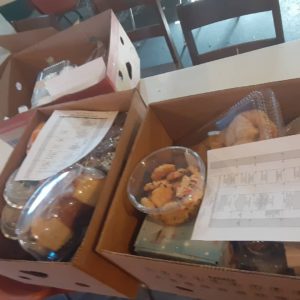
 It is 12:10 and we have just opened up the food pantry. I am waiting for one of the volunteers, and in the meantime, I tell another one about what to expect for the day. This is her first day.
It is 12:10 and we have just opened up the food pantry. I am waiting for one of the volunteers, and in the meantime, I tell another one about what to expect for the day. This is her first day.
Tuesdays are usually our light day, having hot meals, at times, or produce from the Saturday Farmer’s Market, is never consistent, however, what is, are the folks that stop by.
We are visited by neighbors stopping by, not for food, but for fellowship.
“Hello!” I scream as I see a familiar face come through the door. It is Ms. Roxy, she is wearing jeans and a matching blue top, and has her black light cloth face covering on. We chat a little bit, and then I say, “Well don’t let me stop you, come on through and see if there is anything you want.”
“I come to help.” She says to me, as she is wearing her wrist brace that is helping her hand to heal. In spite of her injury, she came to see what she could to, because she said, “I missed everyone.”
But she is not the only one, we had a total of 17 people come, and most were volunteers stopping in to say hi or to see if we needed anything, or to chat with the folks that were there.
People that came to shop walked out with as little as a pound of food, or as much as around 4 or 8 pounds of food that consisted of lettuce from the farmer’s market, produce from the fridge, meat from the freezer, and bakery items.
People got more than food today. They got fellowship, and we all got community. I made sure to let people know that we are having our all volunteer meeting this Thursday at 4 pm and Sunday at 4pm. Here, participants and volunteers can share their input about the pantry. What you like, what you don’t like, what needs to change. We can make changes together. This pantry is built by community, run by community, and guided by community. We need everyone’s voice, so if you like the pantry, it is not good enough for me. I need you to love it. So if you just like it, come to one of the meetings and let’s create an atmosphere that you love. And if you don’t like the pantry, you too, are welcome to come share what is a barrier, so we can create an atmosphere that you perhaps like, and that is on the path for us to create an atmosphere that we all love.
Hope To Thrive’s Holistic Produce Pantry is doing more than just giving food, we are building community.


 After the group left with all the food we had to serve their 30 meals, and a volunteer came to deliver the additional boxes left, I immediately started calling the grocery stores. I was looking to get donated items for Thanksgiving meals the next day. Publix was the first one, “Hi, Sir, I run a food pantry and I am looking for donated items to feed 30 more people tomorrow, and I’m wondering if you would like to be part of this miracle?”
After the group left with all the food we had to serve their 30 meals, and a volunteer came to deliver the additional boxes left, I immediately started calling the grocery stores. I was looking to get donated items for Thanksgiving meals the next day. Publix was the first one, “Hi, Sir, I run a food pantry and I am looking for donated items to feed 30 more people tomorrow, and I’m wondering if you would like to be part of this miracle?” 










